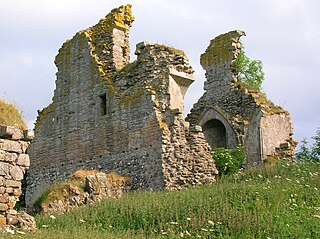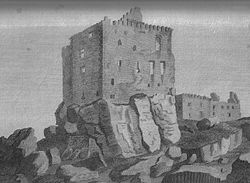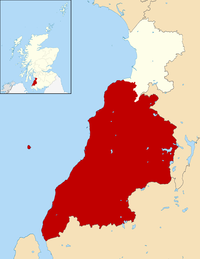
Clan Kennedy is a Scottish clan of the Scottish Lowlands.

The Abbey of Saint Mary of Crossraguel is a ruin of a former abbey near the town of Maybole, South Ayrshire, Scotland. Although it is a ruin, visitors can still see the original monks’ church, their cloister and their dovecot.

Glenluce Abbey, near to Glenluce, Scotland, was a Cistercian monastery called also Abbey of Luce or Vallis Lucis and founded around 1190 by Rolland or Lochlann, Lord of Galloway and Constable of Scotland. Following the Scottish Reformation in 1560, the abbey fell into disuse.

Clan Cunningham is a Scottish clan. The traditional origins of the clan are placed in the 12th century. However, the first contemporary record of the clan chiefs is in the thirteenth century. The chiefs of the Clan Cunningham supported Robert the Bruce during the Wars of Scottish Independence. In the 15th and 16th centuries, the Clan Cunningham feuded with the Clan Montgomery. Historically, the chief of Clan Cunningham held the title of Earl of Glencairn. However, in modern times the chief of the clan is Cunningham of Corsehill. On 18 December 2013, Sir John Christopher Foggo Montgomery Cunninghame, Baronet of Corsehill, was recognized by Lord Lyon as Clan Chief after the chiefship had been vacant for over 200 years.

Kerelaw Castle is a castle ruin. It is situated on the coast of North Ayrshire, Scotland in the town of Stevenston.

Gilbert Kennedy, 4th Earl of Cassilis, PC was a Scottish peer, the son of Gilbert Kennedy, 3rd Earl of Cassilis and Margaret Kennedy. He succeeded to the titles of 6th Lord Kennedy and 4th Earl of Cassillis on 28 November 1558. He fought in the Battle of Langside on 13 May 1568, for the side of Mary, Queen of Scots.

Dunure is a small village in the South Ayrshire area of Scotland about five miles from Ayr, Scotland. It is located on the coast of the Firth of Clyde, and is near to Maybole, south of Ayr.

Busbie Castle was situated in what is now known as Knockentiber, a village in East Ayrshire, Parish of Kilmaurs, Scotland. Knockentiber is 2 miles (3.2 km) WNW of Kilmarnock and 1/2 mile NE of Crosshouse. The castle overlooked the Carmel Glen and its Burn, which runs into the River Irvine, a mile or so to the south, after passing through the old Busbie Mill.

The Barony of Ladyland was in the old feudal Baillerie of Cunninghame, near Kilbirnie in what is now North Ayrshire, Scotland.

Craigie Castle, in the old Barony of Craigie, is a ruined fortification situated about 4 miles (6.4 km) southeast of Kilmarnock and 1 mile (1.6 km) southeast of Craigie village, in the Civil Parish of Craigie, South Ayrshire, Scotland. The castle is recognised as one of the earliest buildings in the county. It lies about 1.25 miles (2 km) west-south-west of Craigie church. Craigie Castle is protected as a scheduled monument.

Dunduff Castle is a restored stair-tower in South Ayrshire, Scotland, built on the hillside of Brown Carrick Hills above the Drumbane Burn, and overlooking the sea above the village of Dunure.

The Murder of Hugh Montgomerie, 4th Earl of Eglinton at the Annick Ford in Stewarton, East Ayrshire, Scotland, took place in 1586 as a consequence of a long running feud between the Montgomeries, Earls of Eglinton and the Cunninghames, Earls of Glencairn, families who were competing for power and influence locally and nationally. The significant repercussions of this act were felt throughout the county of Ayrshire and beyond. The spelling 'Montgomerie' is used throughout for both the family and Montgomery for the clan and clan and district names 'Cunninghame' in the same fashion.

Minishant is a village bordering the A77 in the old county of Carrick, South Ayrshire, Scotland. It is located in Maybole Parish, 3+1⁄2 miles from Maybole and standing close to the River Doon. The village was originally named Culroy after the Culroy Burn that runs through it.

The ruins of the large courtyard style Kyle Castle, once also known as Cavil Castle or occasionally Dalblair Castle lie close to the hamlet of Dalblair in Auchinleck parish near Muirkirk in the East Ayrshire council area, Scotland. The castle stands at the confluence of the Guelt Water and the Glenmuir Water on a peninsula carved out by these rivers. Its name suggests that it was once of some significance.

Jean Stewart, Lady Bargany was a Scottish lady in waiting to Anne of Denmark. She was a younger daughter of Andrew, Master of Ochiltree and Margaret Stewart, Mistress of Ochiltree. Jean was a maiden in the household of Anne of Denmark and her mother was the senior lady in waiting. Her marriage is of special interest to historians.
Thomas Kennedy of Bargany was a Scottish courtier and landowner.

Margaret Kennedy, Countess of Cassilis was a Scottish aristocrat.

The Kennedy Aisle or Bargany Aisle at Ballantrae, South Ayrshire is a vaulted burial chamber and crypt containing a large mural memorial, the Kennedy Monument, an ornately carved stone monument dated to between 1602 and 1605 that commemorates Gilbert Kennedy of Bargany and Ardstinchar, his wife, Janet or Jean Stewart, who died in 1605 and three of their children.

Maybole Castle is a 16th-century castle located on High Street in Maybole, South Ayrshire, Scotland. Originally built for the Earls of Cassillis, it is an L-shaped construction with Victorian two-storey extensions. It is associated with a legend of John Faa, in which an earl killed Faa and imprisoned his wife, the Countess of Cassilis, in the castle.
























